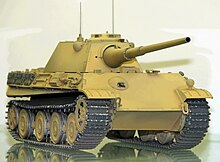Panzerkampfwagen V Panther II
| Panzerkampfwagen V "Panther II" | |
|---|---|

Panther II (with the turret of a Panther Ausf. G) in the Patton Museum of Cavalry and Armor , Fort Knox |
|
| General properties | |
| crew | 5 (commander, gunner, loader, driver, radio operator) |
| length | 8.86 m |
| width | 3.43 m |
| height | 3.10 m |
| Dimensions | > 50 t |
| Armor and armament | |
| Armor | 15-100 / 120 mm |
| Main armament | 7.5 cm KwK 42 L / 70 |
| Secondary armament | 1 × 7.92mm MG 34 1 × 7.92mm MG 42 |
| agility | |
| drive | Gasoline engine Maybach HL 230 P 30 515 kW (700 PS) |
| suspension | Torsion bar |
| Top speed | 46 km / h |
| Power / weight | approx. 15 hp / t |
The Panzerkampfwagen V "Panther II" was a prototype produced in the German Reich during the Second World War and was originally intended to replace the Panther .
Although the first models of the Panther had only just left the factories, a construction contract for a successor model was awarded as early as 1942. The main reason was that the armor of the Panther (80 mm front and 40 mm side armor) did not seem sufficient. The armor should be increased to 100 or 120 mm thick front armor and 60 mm side armor; a revision of the chassis was also planned. In parallel to the development of the Tiger II , which began in 1943 , the planning of the Panther II began. Here, too, the components such as the steering gear, countershaft, rollers, suspension and drive should be interchangeable in order to simplify the production of spare parts and repairs. The numerous modifications increased the total weight to over 50 tons.
In contrast to the Panzerkampfwagen V "Panther" (Ausf. F), the installation of an 8.8 cm KwK 43 was never planned.
After it became clear in early 1943 that the side skirts attached to the Panther offered sufficient protection against close-range fire from the Soviet 14.5 mm anti- tank rifles , the switch to the production of the Panther II was discontinued . Improvements that had resulted from the development of the Panther II should be incorporated into the further development of the Panther , which also happened in the development of the Panther Ausf .
Only a Panther II test chassis was completed. This vehicle was captured by the US Army and taken to the US Army for tests on the Aberdeen Proving Ground (Maryland); However, the turret of a Panther Ausf. G (chassis no. 121447) was only placed on the tub here. Today this tank can be seen in the Patton Army Museum in Fort Knox.
Technical specifications
( Data based on Thomas L. Jentz and Hilary Louis Doyle )
- Armament: 7.5 cm KwK (L / 70) and 2 × 7.92 mm MG 34
- Armor: 100 mm at the front, 60 mm at the sides, 40 mm at the back
- Weight: 53 tons
- Motor: Maybach HL 230 (throttle power 600 PS, constructive 700 PS)
- Speed: 46 km / h
- Crew: 5 men
- Year of construction: 1943
- Quantity: 1 prototype without tower, no tower prototype manufactured (2 prototypes)
- The torso of a prototype tower ("Schmalturm") for the Panther Ausf. F is in the collection of the Bovington Tank Museum in Great Britain. He was used and after the war by the British army bombardment tests then on an English shooting on a Cromwell - hard target placed and forgotten. At the end of the 1980s it was found, processed and exhibited.
See also
- Tank destroyer V
- List of tracked vehicles of the Wehrmacht
- List of special vehicles of the Wehrmacht
Web links
Individual evidence
- ^ Michael Sawodny: German Panzer rarities 1935-1945 , Podzun-Pallas, Friedberg 1982, ISBN 3-7909-0173-3 .
- ↑ a b c d e Thomas L. Jentz , Hilary Louis Doyle: Panzerkampfwagen Panther II and Panther Execution F , Panzer Tracts, Boyds 2006, ISBN 0-9771643-2-2 ( Panzer Tracts. No. 5,4).
- ^ Michael Sawodny: German Panzer Rarities 1935–1945 , Podzun-Pallas, Friedberg 1982, page 25.



